Many Americans believe that opioids are the biggest killers in America, but that’s not true. There’s actually another culprit that lurks in the shadows and often conceals itself as something else. According to new data from the National Institute on Alcohol Abuse and Alcoholism and the Centers for Disease Control and Prevention, 88,000 Americans are killed by alcohol-related causes each year. That’s a significant amount. It’s also much more than the estimated 72,000 people who die from overdoses each year. It’s clear that alcohol is not only a silent killer but also a major killer as well. 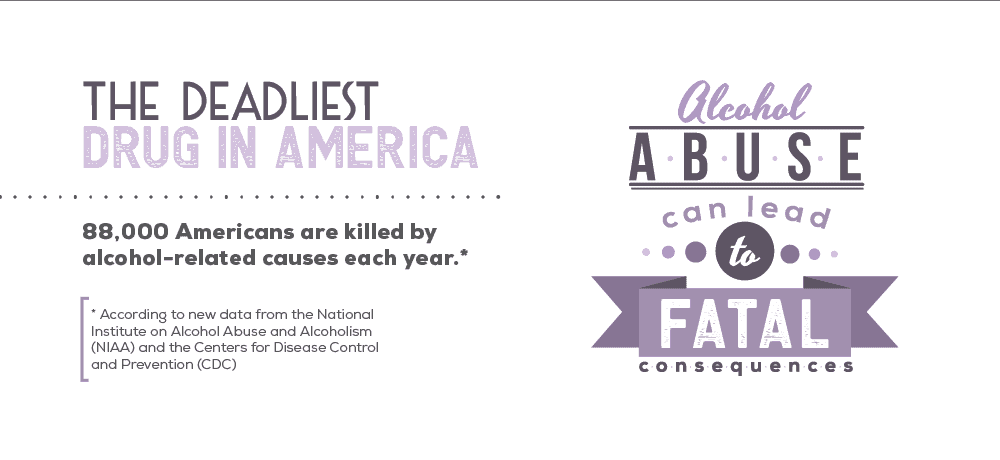 Alcohol is killing more and more Americans. It’s especially targeting young Americans and women. Many people see alcohol as harmless fun. A couple of nights of binge drinking or a glass of wine after every meal may even seem normal to many Americans. However, the truth of the matter is that alcohol abuse can lead to deadly results. Learn more about how alcohol is killing more people now than ever before.
Alcohol is killing more and more Americans. It’s especially targeting young Americans and women. Many people see alcohol as harmless fun. A couple of nights of binge drinking or a glass of wine after every meal may even seem normal to many Americans. However, the truth of the matter is that alcohol abuse can lead to deadly results. Learn more about how alcohol is killing more people now than ever before.
“Get the help you need today. We offer outpatient assistance, so you can maintain your work, family, and life commitments while getting the help you deserve!”
How Alcohol Can Kill You
Alcohol kills more people than overdoses. While alcohol poisoning and overdoses can kill, alcohol often kills quietly by damaging internal organs and more. Alcohol abuse and addiction can lead to the development of many physical health conditions and mental health conditions. Let’s explore some alcohol-related complications below. 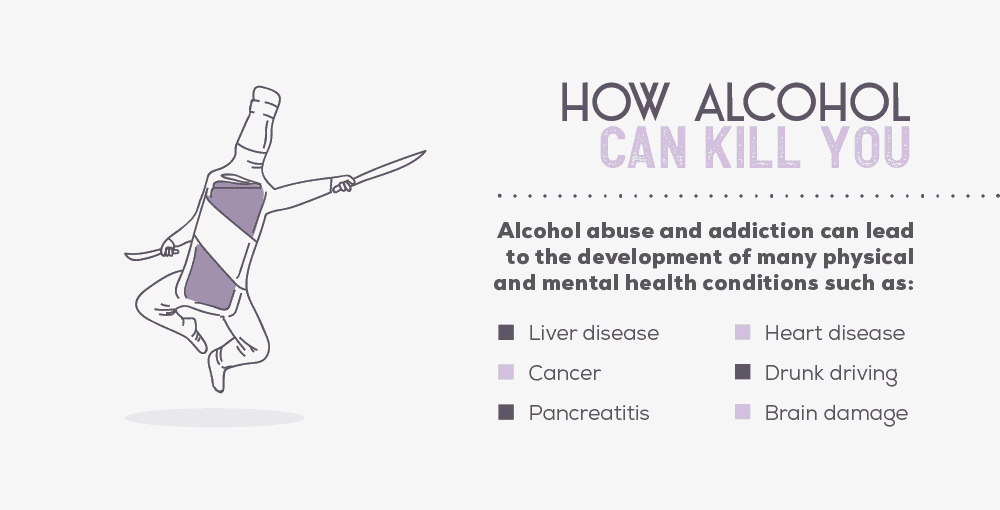
Liver Disease
As alcohol is metabolized by the liver, excessive alcohol consumption may actually damage the liver. Liver disease is common amongst heavy drinkers. Although minimal liver damage can be reversed if the damage is caught early, significant damages are permanent and irreversible. https://www.youtube.com/embed/xaTYclP8F8Q Alcohol destroys or alters liver cells. It causes more fatty deposits to accumulate at the liver. It also causes inflammation or permanent scarring. This continuous damage can be difficult to detect. Most people don’t realize that they are damaging their liver. By the time that they’ve developed liver disease, it may be too late. There are three different types of liver diseases associated with alcoholism:
- Fatty liver disease. This is the earliest stage of alcohol-related liver disease. This is defined as a liver that is more than 5% fat. Symptoms of fatty liver disease include poor appetite, weight loss, abdominal pain, physical weakness, and fatigue. Mild forms of fatty liver disease are reversible.
- Alcoholic hepatitis. Fatty liver disease can progress to alcoholic hepatitis. This happens when the liver becomes inflamed. Common symptoms of alcoholic hepatitis include stomach pain, jaundice, vomiting, appetite loss, and nausea.
- Cirrhosis. The most serious type of alcohol-induced liver disease is cirrhosis. This happens when normal liver tissue becomes scar tissue. About 10% to 20% of heavy drinkers develop cirrhosis. It usually takes about 10 years for heavy drinkers to develop this disease. Cirrhosis is not reversible.
Alcohol-induced liver diseases, like the ones above, can also cause liver cancer and other ailments and conditions. These are silent killers. Alcohol can also increase the rate of liver damage and disease in someone who has liver disease. For example, those who have hepatitis C are vulnerable to alcohol-related complications related to the liver. These individuals should not drink alcohol.
Cancer
All types of liquor have been linked with an increased risk of cancer. This could be because ethanol and acetaldehyde can damage the DNA of healthy cells. Alcohol can also prevent the breakdown of estrogen. Excessive amounts of estrogen can lead to an increased risk of cancer in women. Alcohol consumption can also prevent the body from absorbing important nutrients like vitamin A, C, D and E. It can also prevent the body from absorbing folate and carotenoids. Cancers that are often associated with alcoholism include:
- Head and neck cancers, like oral cancer, throat cancer, and larynx cancer
- Breast cancer, especially in women
- Esophageal cancer
- Liver cancer
- Colorectal cancer
- Pancreatic cancer
Those who drink a lot are more at risk of developing cancers. Oral cancer and other head and neck cancers are especially common as alcohol comes into direct contact with these areas of your body.
Pancreatitis
Pancreatitis is one of the first alcohol-related complications that people were aware of. This disease happens when the pancreas becomes inflamed. This is usually because digestive enzymes begin attacking the pancreas. Three major types of cells in the pancreas become damaged: acinar cells, ductal cells, and stellate cells. Damage to these cells leads to calcification and fibrosis. There are two different types of pancreatitis. They include:
- Acute pancreatitis, which is a sudden inflammation of the pancreas for short periods of time. Acute pancreatitis can lead to infection and cyst formation. It can also harm other vital organs, like the kidneys and the lungs. With that said, acute pancreatitis is usually a condition that can be reversed with the right type of treatment. Common symptoms of acute pancreatitis include acute abdominal pain and raised serum lipase and amylase levels.
- Chronic pancreatitis, which is long-lasting inflammation of the pancreas. This type of pancreatitis is a lot more severe. The damage caused by chronic pancreatitis can be irreversible and permanent. Common symptoms of chronic pancreatitis include malabsorption of food, upper abdominal pain, and weight loss.
Pancreatitis can be quite serious and severe. It is no laughing matter. Even acute pancreatitis can lead to fatal consequences. In fact, 1 in 5 cases of acute pancreatitis can lead to life-threatening consequences, like multiple organ failure.
Heart Disease
The relationship between alcohol and heart disease is rather tricky. While some studies show that drinking one glass of wine a day can help prevent heart diseases, drinking too much alcohol will most definitely lead to heart disease. Too much liquor will raise triglyceride levels in the blood. This can cause the alcohol user to be more vulnerable to high blood pressure, heart failure and obesity. The latter can lead to a stroke, cardiomyopathy, and cardiac arrhythmia. In extreme cases, it can also lead to sudden cardiac death.
“We accept many health insurance plans. You can get your life back in order with our outpatient program today!”
Drunk Driving
Did you know that 29 Americans die in motor vehicle crashes that involve an alcohol-impaired driver every day? That’s a significant sum and is probably one of the main ways that alcohol can kill. Those who drive drunk are less likely to make good judgment calls. This may cause them to make risky decisions that can lead to fatalities. In general, women are less likely than men to drive while intoxicated. This may be due to the fact that women are generally less prone to risk-taking in comparison to men. A recent study found that only 17% of women found it acceptable to drive after drinking one or two drinks. In comparison, 27% of men found it acceptable to drive.
Brain Damage
Magnetic resonance imaging has found that alcoholics may sustain serious brain damage. Brain regions involved with coordinating multiple brain functions were significantly smaller in alcoholics than in non-alcoholic individuals. In fact, excessive alcohol consumption can lead to what is known as ‘wet brain’. This type of brain damage is not only permanent but also extremely serious. Alcohol consumption can also lead to impairment. The damage may be irreversible, and those who are addicted to alcohol may see a significant decline in their cognitive functioning and abilities. Brain damage can lead to the development of many mental health conditions. Some heavy drinkers may develop symptoms of depression and anxiety. There is a strong correlation between alcoholism and suicide. Heavy drinkers are much more likely to commit suicide in comparison to non-drinkers. This could be because alcohol can significantly affect brain chemistry levels and cause them to become imbalanced.
Alcohol Deaths Up 35% and 65% Are Among Women
Recent studies found that deaths caused by alcohol rose 35% from 2007 to 2017. 67% of these deaths are among women. 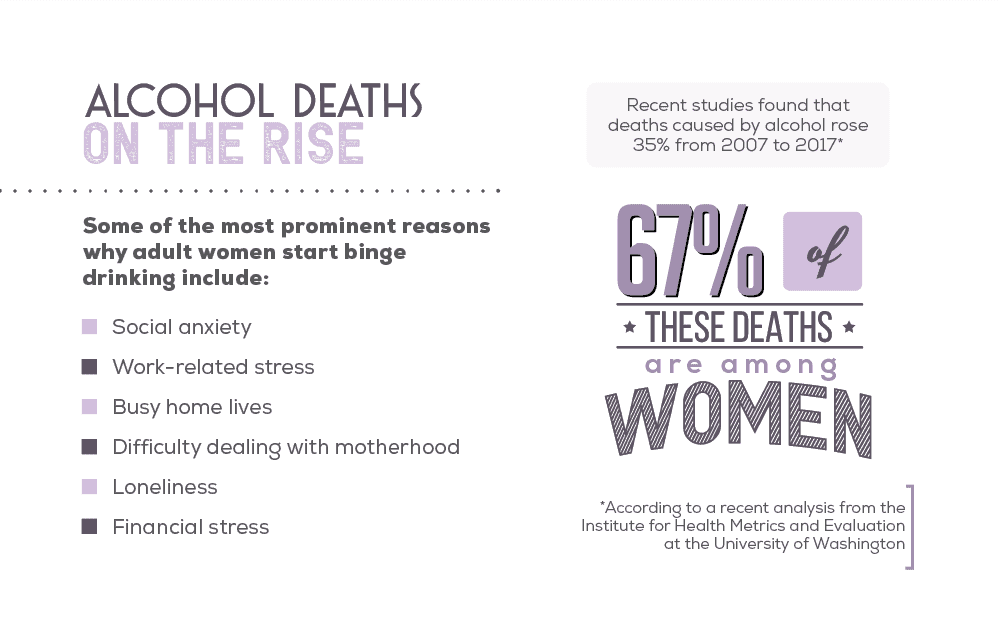 This begs us to question why alcohol deaths are more prevalent among women than men. Understanding the primary reason why women are more likely to abuse alcohol is critical in our war against addiction. According to Ali Mokdad, a professor at the Institute for Health Metrics and Evaluation, alcohol use disorders manifest differently in each gender. While men are more likely to get into bar fights or respond in an angry manner, women are more likely to drink as a way to de-stress from work. Women are also more likely to drink in response to despair. “[Women] just aren’t going to call home and say they’re stopping for a couple drinks after work with friends or going to the gym to unwind. Instead, they often go home and drink wine while making dinner, which can lead to a nightly pattern of excessive drinking.” ~ Stefanie Wilder-Taylor, author of Sippy Cups Are Not for Chardonnay Studies show that drinking at home is considered the norm for many women, especially for those who are mothers. A recent study found that 10% of pare ts believe that having at least two drinks a day is reasonable for reducing stress. Work-related stress and busy home lives are not the only causes that are driving the rising alcohol abuse rates. Loneliness, financial stress from the recent economic recession and other pressures are causing more women to turn to merlot and chardonnay.
This begs us to question why alcohol deaths are more prevalent among women than men. Understanding the primary reason why women are more likely to abuse alcohol is critical in our war against addiction. According to Ali Mokdad, a professor at the Institute for Health Metrics and Evaluation, alcohol use disorders manifest differently in each gender. While men are more likely to get into bar fights or respond in an angry manner, women are more likely to drink as a way to de-stress from work. Women are also more likely to drink in response to despair. “[Women] just aren’t going to call home and say they’re stopping for a couple drinks after work with friends or going to the gym to unwind. Instead, they often go home and drink wine while making dinner, which can lead to a nightly pattern of excessive drinking.” ~ Stefanie Wilder-Taylor, author of Sippy Cups Are Not for Chardonnay Studies show that drinking at home is considered the norm for many women, especially for those who are mothers. A recent study found that 10% of pare ts believe that having at least two drinks a day is reasonable for reducing stress. Work-related stress and busy home lives are not the only causes that are driving the rising alcohol abuse rates. Loneliness, financial stress from the recent economic recession and other pressures are causing more women to turn to merlot and chardonnay.
The Difference Between Binge Drinking and Alcoholism
Binge drinking and alcoholism is not the same thing. It’s possible for someone to binge drink without developing alcoholism. This simply means that they are drinking unhealthy amounts. Alcoholism refers to a physical or chemical dependence on alcohol. Those who struggle with alcoholism will crave alcohol and may need it to function throughout the day. According to the U.S. Department of Health and Human Services and U.S. Department of Agriculture, moderate drinking is defined as having up to 1 drink per day for women and up to 2 drinks per day for men. Men can generally drink more than women due to their body fat percentage and weight. Men also metabolize alcohol differently than women. 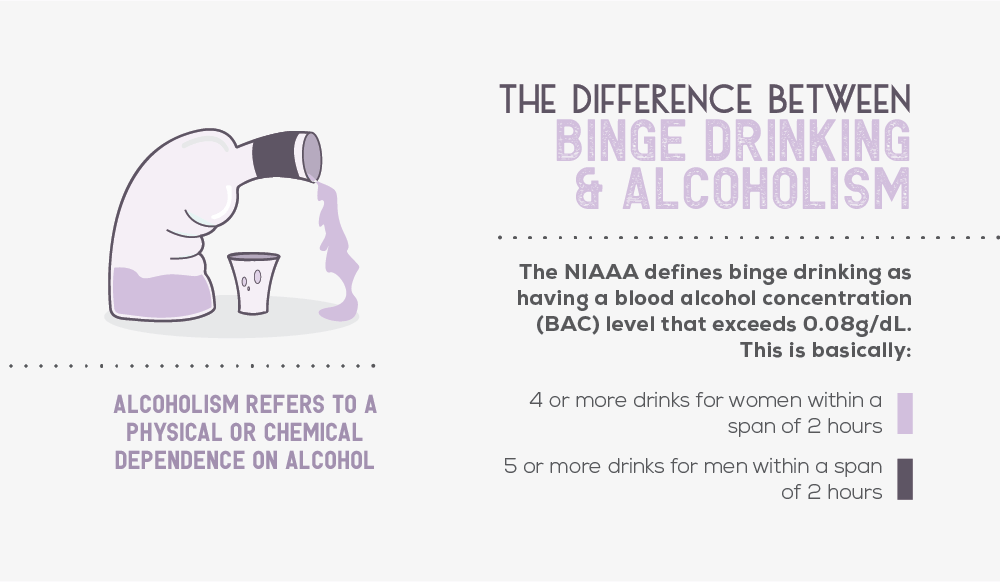 The National Institute on Alcohol Abuse and Alcoholism (NIAAA) further defined binge drinking as having a blood alcohol concentration (BAC) level that exceeds 0.08g/dL. This is basically:
The National Institute on Alcohol Abuse and Alcoholism (NIAAA) further defined binge drinking as having a blood alcohol concentration (BAC) level that exceeds 0.08g/dL. This is basically:
- 4 or more drinks for women within a span of 2 hours
- 5 or more drinks for men within a span of 2 hours
Women should not drink more than 7 alcoholic drinks a week and men should limit their drinks to under 14 alcoholic drinks per week. Anything more than that and an individual will be susceptible to developing an alcohol use disorder (AUD). Binge drinking can lead to alcohol poisoning, sexual dysfunction, and accidents. Those who binge drink are also more likely to engage in risky behavior, like unsafe sex. They’re more likely to contract sexually transmitted diseases and are more likely to get pregnant. Once binge drinking is defined, it’s also possible to define heavy alcohol use. Heavy alcohol use is characterized as binge drinking for more than 5 days in one month.
Signs of Alcoholism
Alcoholism is basically an addiction to alcohol. The fifth edition of the Diagnostic and Statistical Manual of Mental Disorders (DSM-5) has set out 11 criteria as a definition for alcoholism. Anyone who meets 2 out of 11 following criteria can be diagnosed with an alcohol use disorder (AUD):
- Needing to drink more and more alcohol to achieve the same effects due to an increase in overall tolerance
- Experiencing withdrawal symptoms when quitting that can only be relieved by drinking alcohol
- Drinking in larger amounts or for longer periods than intended
- Wanting to stop drinking, but being unable to
- Experiencing cravings or urges to drink throughout the day
- Drinking even when it causes dangerous or negative situations
- Neglecting school or work responsibilities in favor of drinking
- Spending a lot of time hung over or obsessing over alcohol
- Continuing to drink even when it causes problems in one’s life
- Giving up social circles, friends or outings in order to drink
- Continuing to drink even when it causes physical or psychological harm
Anyone who meets four or five of these criteria have a moderate alcohol use disorder (AUD) that needs to be treated. Anyone who meets six or more of these criteria have a severe and serious AUD. These individuals need professional help. Their lives may be at risk.
“We treat both addiction and co-occurring disorders and accept many health insurance plans. Take a look at our outpatient program today!”
Does Alcohol Addiction Treatment Work?
Alcohol addiction treatment does indeed work. It’s a better approach to recovery than attempting to do it on your own. Those who seek this type of substance abuse treatment will generally have an easier time abstaining from alcohol and avoiding relapses. 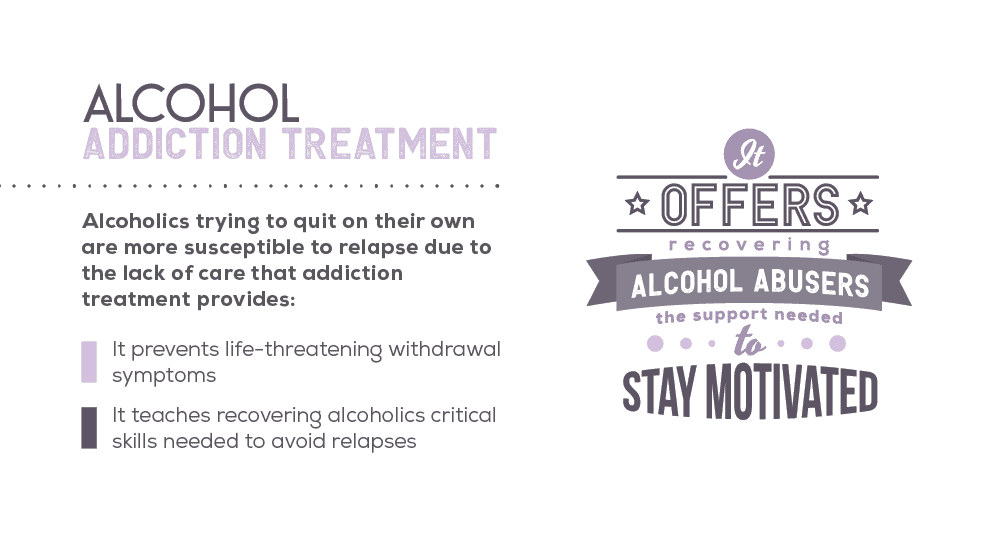 Heavy drinkers, especially, should seek professional help when trying to quit drinking. They’re the least likely to succeed without an addiction treatment plan. Alcohol addiction works because it:
Heavy drinkers, especially, should seek professional help when trying to quit drinking. They’re the least likely to succeed without an addiction treatment plan. Alcohol addiction works because it:
- Prevents life-threatening withdrawal symptoms
- Teaches patients essential independent living skills needed to get their lives back on track
- Teaches recovering alcoholics critical skills needed to avoid relapses
- Offers recovering alcoholics a stress-free environment for recovery, and provides structure in an otherwise chaotic situation
- Offers recovering alcohol abusers the support needed to stay motivated
Most alcohol addiction treatment programs start off with detox. Then, patients will get to try an assortment of behavioral therapies and counseling. Each alcoholic will need something different to succeed in his or her recovery. Due to this reason, each alcohol addiction treatment plan must be carefully tailored to meet the specific needs of each addict.
Types of Alcohol Addiction Treatment
When seeking professional alcohol detox and rehab services, it’s vital to consider the types of alcohol addiction treatment options that are available. In general, treatment can be separated into two different levels of care. They include:
- Inpatient care. With this type of alcohol addiction treatment, patients receive around-the-clock supervision and care. Patients will live at the rehab facility for not only the detox process but also for several weeks after. This allows them to easily gain access to addiction experts and addiction treatment services. Patients will usually stay at the alcohol rehab center for anywhere from 28 to 90 days in total. Longer treatment lengths may be more beneficial to those with a more severe addiction.
- Outpatient care. This type of alcohol addiction treatment offers optimal flexibility and freedom. Patients make a trip to the alcohol rehab facility whenever they need treatment. There are many different types of outpatient treatment programs. There are Partial Hospitalization Programs (PHPs), which offer either day treatment or night treatment, and Intensive Outpatient Programs (IOPs), which require a commitment of at least 9 hours a week.
Each alcohol rehab facility will specialize in something different. Each treatment facility will also be able to offer various amenities and services. Upon choosing the type of alcohol addiction treatment that will work best, consider taking a tour of the facility to get a better idea of what to expect. Meet the staff and see what type of atmosphere each place can offer. 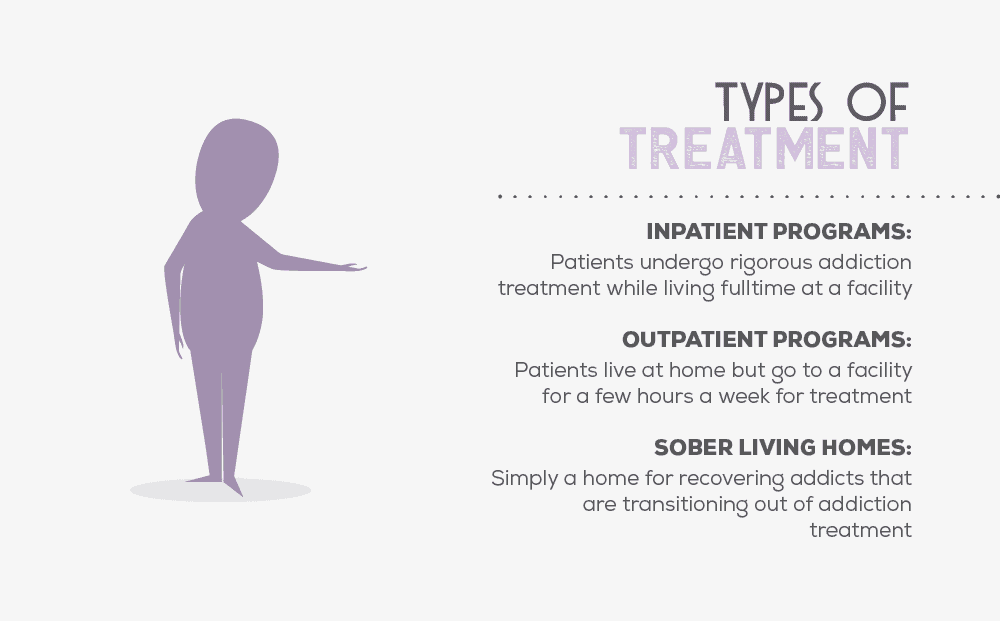 Look for an alcohol addiction treatment facility with Joint Commission Accreditation. These treatment facilities use evidence-based treatment approaches that come with proven outcomes. Those who choose an accredited alcohol treatment center will receive a higher quality of service and will be much more likely to succeed in their recovery.
Look for an alcohol addiction treatment facility with Joint Commission Accreditation. These treatment facilities use evidence-based treatment approaches that come with proven outcomes. Those who choose an accredited alcohol treatment center will receive a higher quality of service and will be much more likely to succeed in their recovery.
Sober Living Homes
Those who have completed an addiction treatment program can consider continuing their treatment by moving into a sober living home. Sober living homes are very different from halfway houses. For one, they’re not mandatory. Those who decide to live in a sober living home will do so by choice. It’s basically the same as living in an apartment or renting a room in a house with other recovering alcoholics. Residents can come and go as they wish, and can even invite friends over. Drugs and alcohol are not allowed in sober living homes. Each sober living home will have its own requirements and house rules. For example, some sober living homes may require residents to participate in group therapy at least once a week. This type of environment is ideal for those who are looking to get their lives back on track. They learn how to live with others, and they also get an opportunity to stay connected with those in similar situations. Sober living home arrangements can offer recovering alcoholics a lot of support. They can help keep many recovering alcohol abusers on the right track. There is no time limit as to how long someone may live in a sober living home. Many recovering alcohol abusers may stay at a sober living home for months, if not years. It all depends on how long it takes for them to feel ready to go out there on their own.
Effective Types of Behavioral Therapy
Behavioral therapies are an important part of any addiction treatment program. With behavioral therapy, recovering alcoholics will work with counselors to identify the behaviors that caused them to fall victim to alcoholism in the first place. They’ll then learn how to correct these behaviors and how to lead a healthier life. Behavioral treatments will help recovering alcoholics develop the skills needed to abstain from drinking. These treatments will also help recovering alcohol abusers build strong social support networks and learn how to set and achieve goals related to their drinking. Recovering addicts will also learn how to identify triggers that cause them to drink and how to cope or avoid them to avoid relapses. There are many different types of behavioral therapies. Each alcohol rehab facility will offer different options to choose from. Let’s take a look at some of the most common options to choose from below.
Cognitive Behavioral Therapy (CBT)
Cognitive Behavioral Therapy (CBT) is one of the most highly recommended behavioral therapies at alcohol addiction treatment centers. This type of psychotherapy focuses on finding solutions to existing problems. For example, patients are encouraged to challenge distorted beliefs and to change destructive and negative behaviors. The whole concept behind CBT is that thoughts and emotions can change a person’s behavior. Due to this reason, people should focus on changing their thoughts and emotions. If they do, they may respond differently to various situations and scenarios. During therapy, patients will try to identify harmful or destructive thoughts. They will then dissect whether these thoughts are a good representation of reality. If they are not, they will need to find a way to overcome these thoughts.
Motivational Enhancement Therapy (MET)
Motivational Enhancement Therapy (MET) helps recovering alcoholics accept recovery. This type of psychotherapy is also very effective in treating co-occurring disorders. There are 4 main principles associated with MET. They include:
- Learning how to develop and express empathy
- Acknowledging the differences between one’s thoughts and reality
- Trying to build a positive outlook and perception of MET
- Striving towards self-efficacy and steps toward achieving life goals
MET is often paired with CBT and 12-step programs for optimal efficacy. This type of therapy helps patients stay motivated when attempting recovery. The patient’s mindset is critical to his or her success.
Dialectical Behavioral Therapy (DBT)
Dialectical Behavioral Therapy (DBT) is a bit different from CBT. This form of behavioral therapy aims to equip patients with the skills needed to manage painful and unhappy emotions. They also help patients learn how to avoid conflicts in relationships. Like MET, there are four parts to DBT. They include:
- Mindfulness and becoming more self-aware of one’s actions and thoughts
- Distress tolerance to increase a person’s tolerance of negative thoughts and emotions
- Emotion regulation to help patients learn how to manage and even change their emotions
- Interpersonal effectiveness to help patients learn how to communicate their needs and feelings in a respectful and assertive manner
DBT will directly treat an addiction to alcohol and indirectly improve relationships. Patients will need to learn and practice these skills with a therapist. They may then move onto group therapy, where they can practice the skills learned on other patients as well.
Motivational Interviewing
Motivational Interviewing is a type of client-centered therapy. It’s usually practiced on patients who are resistant to change. Motivational Interviewing will help patients better understand why they are resistant to changing their lifestyle for the better, and what they can do to stay motivated to change. Patients learn how to make decisions that will guide them towards a healthy change in their life. During the sessions, the therapists will help patients figure out why they are not only resistant to change but also in denial that they have a problem. The therapists will then help patients set practical goals that will allow them to achieve the results that they desire. Patients figure out what they want to work and the reasoning behind their desire to do so.
Eye Movement Desensitization and Reprocessing (EMDR)
https://www.youtube.com/embed/8552cfDn8pQ Eye Movement Desensitization and Reprocessing (EMDR) is the therapy of choice for those who have experienced a traumatic event. These individuals may turn to drug abuse or alcohol abuse in order to cope with the trauma. The trauma can be anything from PTSD to sexual abuse. EMDR is a set of exercises that rely on rapid eye movements to help ‘reset’ the brain. The exercises help patients use rapid eye movements in conjunction with past memory recall to change how they feel about traumatic events. Each EMDR cycle consists of eight phases. In general, it should take patients several weeks to complete all eight phases. This type of behavioral therapy can also be classified as talk therapy. It’s a unique type of therapy that has proven to offer excellent results. Many patients claim to feel better about the traumatic event after just one EMDR session. There are many benefits to EMDR. For one, this type of therapy is often quite affordable. It’s also covered by most health insurance plans.
Rational Emotive Behavior Therapy
Rational Emotive Behavior Therapy (REBT) is another form of behavioral therapy. This type of therapy is quite similar to CBT. It addresses negative thoughts and emotions and tries to find practical solutions that will help patients achieve their goals. With that said, there are some philosophical differences between REBT and CBT. For one, REBT recognizes that some negative emotions and thoughts are constructive. They help patients make better decisions in their lives. This type of behavioral therapy also focuses heavily on Unconditional Self Acceptance (USA). There are also some minor philosophical differences. Some patients may decide to combine CBT with REBT. Others may try CBT first. If CBT doesn’t work for them, they may try REBT to see whether a different philosophical approach may change their perspective. REBT meetings have proven outcomes.v
Alcohol Addiction Medication
Medical detox is another crucial component of many addiction treatment programs. Depending on the type of withdrawal symptoms that clients experience, addiction experts will prescribe different cocktails of medications to help clients recover. The Food and Drug Administration (FDA) has approved several alcohol addiction medications. These medications will curb cravings and ease withdrawal symptoms. They can also help prevent deadly alcohol withdrawal symptoms, like delirium tremens. In most cases, alcohol detox is absolutely necessary. The detox process usually takes anywhere from 7 to 10 days to complete. After detox is complete, clients should be free of most, if not all, physical withdrawal symptoms. With that said, they may still experience some psychological withdrawal symptoms, like cravings, from time to time. Let’s take a look at some of the alcohol addiction medications available below.
Acamprosate
Acamprosate is perhaps the safest and most prescribed medication used to treat alcohol addiction. Since 1989, this medication has been used to treat over 1.5 million alcoholics. This drug was officially approved by the FDA in 2004, as it can make it easier for recovering alcoholics to abstain from alcohol use. This prescription medication works by acting on both glutamate receptors and gamma-aminobutyric acid (GABA) receptors. Acamprosate reduces hyperactivity associated with alcohol consumption. It helps prevent withdrawal symptoms like difficulties sleeping and restlessness.
Benzodiazepines
Alcohol withdrawal seizures and delirium tremens can also be treated with benzodiazepines. These prescription medications have seen a lot of therapeutic success and very few side effects. Benzodiazepines can also be used to treat nausea and vomiting and chills and sweats. Common benzodiazepines used for treating alcohol withdrawals include chlordiazepoxide, diazepam, lorazepam, and oxazepam.
Disulfiram
Another extremely popular alcohol addiction medication is disulfiram. This is an acetaldehyde dehydrogenase inhibitor that stops the body from metabolizing alcohol. Anyone who is on disulfiram will feel extremely sick if they ever decide to drink again. They also won’t feel any of the positive effects of alcohol. This can prevent many recovering alcoholics from relapsing. The effects of disulfiram will kick in after 10 minutes and should last for approximately an hour. This medication does not treat withdrawal symptoms, but it can effectively prevent alcohol consumption among recovering alcoholics. Most recovering alcohol abusers will take a pill once a day for optimal effects. It’s important to note that disulfiram can react with any amount of alcohol. As a result, those who take this medication need to be careful when consuming anything. Some cough medicines and prescription medications may contain alcohol.
Naloxone
Naloxone is most often used to treat opioid addictions; however, it can also be used to treat an addiction to alcohol as well. Naloxone reduces alcohol cravings and encourages recovering alcoholics to abstain from alcohol. The effects of naloxone generally kick in with 3 to 5 minutes and will last for up to 90 minutes. Naloxone is an important drug that can help reverse the effects of overdoses. It’s especially useful in reversing the effects of an opioid overdose. This prescription drug is often found in other medications as well. For example, it is an active ingredient and chemical in Suboxone.
Naltrexone
Naltrexone, also known as Vivitrol, is a once-a-month injection that can block alcohol cravings. This medication can remove any euphoric feelings associated with drinking; thus, preventing an alcoholic from drinking once again. This prescription medication makes it easier for recovering alcoholics to put down the bottle and abstain from liquor for good. Naltrexone is an antagonist. This means that it attaches to alcohol receptors in the brain and central nervous system (CNS) to prevent them from getting stimulated. Even if alcohol is present in the body, it cannot stimulate these receptors and cause any effects. This prescription drug is a bit unique in the sense that those who take it must be alcohol-free for at least 7 to 14 days. If not, they may experience adverse side effects.
Other Medications
What Is Alcoholics Anonymous?
Alcoholics Anonymous (AA) is a fellowship of men and women who have one thing in common; they all want to stop drinking. Founded in 1935, AA was designed by recovering alcoholics who wanted to help others who were struggling with sobriety. This program follows twelve faith-based steps and principles. Members put their faith in a power greater than themselves. AA meetings are free. At these meetings, members will reflect on their current situation and also figure out what steps they can take next to stay sober. They also learn more about each step through step studies and book studies. AA meetings welcome everyone. While these meetings are faith-based, they are not affiliated with any religions. Agnostics, atheists, and people with any religious background are welcome to attend. These meetings are self-supporting and non-professional. Everything that’s shared in these meetings will be kept 100% confidential. It’s a safe space for venting about one’s struggles with alcoholism and for learning more about this disease.
The Difference Between 12-Step Programs and Therapy
While 12-step programs may appear similar to therapy, it’s honestly quite different in many different ways. For one, 12-step meetings are merely a fellowship of men and women who want to get sober. These recovering addicts follow the same twelve steps and principles. With that said, the meetings are not led by a qualified and trained therapist. Those who attend 12-step meetings also do not give advice to one another. This is because they’re not qualified to offer any suggestion. Instead, they merely offer other members a shoulder to lean on and a sympathetic ear. Therapy is quite different in this regard. The therapist is trained to help patients work through their problems. Not only will they listen to their patients, but therapists can also offer some guidance and advice. Another important thing to note is that 12-step programs are free to attend while therapy can get quite expensive. The atmosphere and mood of both of these meetings are also very different. With that said, both 12-step programs and therapy are very similar to one another. They, however, should not be used to replace one another, as they supplement one another.
As Alcohol Continues to Kill More People Each Year, Americans Should be Wary of Alcohol Misuse and Abuse
Alcohol is causing a significant amount of damage to America. In 2010, the economic costs of excessive alcohol use topped $249 billion. These numbers have only continued to rise over the years. Most of these costs are associated with a loss in workplace productivity, health care expenses, criminal justice expenses and losses caused by auto vehicle accidents related to excessive alcohol use. It’s time for us to stop burying our heads in the sand and see alcohol for what it is. It’s a huge killer in America. Fortunately, there are quite a few resources out there that can help alcohol abusers get their lives back on the right track. Those who are abusing alcohol can seek help from an alcohol detox and rehab facility. They can also get support from the community via recovery meetings. We don’t have to sit idle any longer while alcohol continues to kill. We can put a stop to alcohol abuse, as we have the resources to do so. The only thing that’s missing is an initiative to raise awareness for this issue. Americans should be made aware of the dangers of drinking. It’s easy for a glass of wine every night to transform into a full-on addiction. Did you enjoy this blog? Or, did you find it informative? Let us know what you think in the comments below!
What Did you Think About This Blog?
Give it a Rating!

